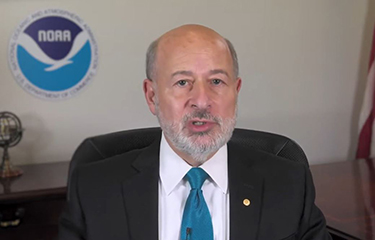The head of the National Oceanic and Atmospheric Administration said he is confident the agency is back on track in conducting fisheries stock surveys following criticism from some U.S. lawmakers.
Reduced surveys in recent years “were compounded by issues like Covid and workforce,” NOAA Administrator Richard Spinrad told lawmakers in a July budget hearing.
“I’m confident that we’re on a much better track now than we were in years past," he said.
Stock surveys are a critical tool for U.S. fisheries regulators, giving them a snapshot of the health and abundance of fish and helping them set sustainable harvest rates for commercial fisheries. However, NOAA Fisheries has canceled multiple surveys in recent years, leading to frustration from commercial fishermen who claim the agency’s regulations are based on outdated survey data.
“When you miss a survey, it’s a big deal because then you can’t build on what happened the previous year,” U.S. Sen. Dan Sullivan (R-Alaska) told Spinrad at the hearing.
“I meet with our fishing community on a very regular basis … and they have emphasized that NOAA continues to fall short on the needs for surveys in Alaska,” Sullivan added. “It’s a frustration because it’s the core mission of NOAA.”
During Covid-19, NOAA conducted just one survey in Alaska, Sullivan said. At the same time, the state government of Alaska was able to complete all its planned surveys.
“I was disappointed by that,” Sullivan said.
Other lawmakers have expressed similar frustration with the canceled surveys. In its July report on the annual appropriations bill that funds NOAA, lawmakers on the U.S. Senate Appropriations Committee called any reduction in survey coverage “fundamentally unacceptable.”
“The committee is increasingly concerned that federal vessel-based fisheries surveys necessary for determining the sustainable and optimal harvest rates for commercial fisheries have been canceled with increasing frequency in recent years, without effective contingency plans for covering the resulting data gaps,” the report said..
The Senate version of the legislation mandates a minimum of six Alaska bottom-trawl surveys.
In response to Sullivan’s questioning, Spinrad said the reduction in surveys was a temporary issue and the agency would conduct more than the required number of surveys in 2023.
“We’re required to assess 200 stocks every year; This year, we’ve already conducted 147 surveys and we’re on track to do 213,” Spinrad said.
In addition, U.S. Rear Admiral Nancy Hann, director of the NOAA Office of Marine and Aviation Operations and director of the NOAA Commissioned Officer Corps, said the agency was working to address staffing shortages that had impacted its ability to conduct surveys.
"It’s a reality, it’s not an excuse,” Hann said. “There’s never been a wider gap in the maritime workforce internationally.”
NOAA has a 9 percent workforce gap, she said, but the agency has taken steps to address it. NOAA hired 100 mariners – the most it’s ever hired in a fiscal year – and plans to hire 20 more. Attrition has also dropped from 23 percent to 13 percent over the last year, well below the industry average of 25 percent, Hann said.
NOAA Fisheries is also rolling out the use of autonomous vessels to supplement its survey efforts, a technology Spinrad said showed great promise.
“At the end of the day, there’s a limit to how much we can do and what we can do with our large vessels. If we can supplement that with uncrewed systems and get even more data, that’s even better,” he said.
Both Spinrad and Hann said NOAA budget increases over the last few years, as well as additional funding appropriated in the Inflation Reduction Act, have helped the agency get back on track.
NOAA Fisheries is set to receive a budget cut next year, driven partly by a debt ceiling deal between U.S. House Republicans and the administration of U.S. President Joe Biden that limits discretionary spending. The Senate version of the appropriations bill includes USD 1.1 billion (EUR 978 million) for NOAA Fisheries, USD 19 million (EUR 17 million), or 1.7 percent, less than it received for fiscal 2023.
Photo courtesy of Group on Earth Observations







